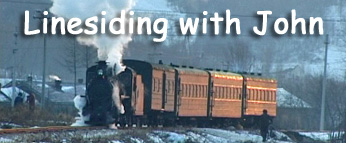

Overview – added 28 May
Although we applied for permission to Bord na Mona head office, we
received no reply before we left and it proved unnecessary anywhere we
went. If it’s a large site with an office, you will need to ask for
permission there. If not, it is not really necessary to enter the
buildings to find someone working on a tractor to ask permission. They
are in no more of a position to grant it than anyone in the yard. Just
be friendly, explain why you are there to anyone who is interested and
ask if it is OK. We didn’t have any refusal. You are expected to wear
hi-vi jackets on BnM property with safety glasses in the works. If you
don’t have these, ask to borrow them on site. You’ll quickly end up
with ones you can call your own.
English is not a foreign language in Ireland (unlike some parts of Wales) so you can easily communicate even if the accent is sometimes as challenging as the deepest Geordie.
Our information came from a somewhat-dated ‘Locomotives & Railcars of the Bord na Mona’ by Stephen Johnson (Midland Publishing 1996) and from notes provided by Ted McAvoy (email him for the latest version tedmcavoyREPLACEWITHATbtinternet.com). He is also working on a Bord na Mona book for Oakwood Press due to be published in 2011.
The locos used on the peat trains are primarily modern 4wDH locos either new-builds by BnM, Hunslet or Hunslet Wagonmaster conversions (also by BnM). The latest Wagonmaster conversions are to 0-4-0DH and still retain their rod drives which if they catch on will be visually more attractive than the 4wDH on the peat trains. Unrebuilt Wagonmasters are normally found on the service trains (static for long hours along with a fuel wagon at tea centres on remote bogs) and on pw trains. Rustons may be found working tipplers or at smaller sites. Most other locos by Gleismac, Deutz and Simplex are dumped. Rail tractor conversions and PW machines can also be found working but railbuses are a thing of the past and most employees get to/from work by car.
The peat trains often operate in pairs and this facilitates moving the locos from the back to the front of trains on the bogs for the return and also open/closing crossing gates. It also provides back-up in the event of loco failure.
Peat is mainly milled peat these days which is scraped and mounded by tractor hauled equipment and then loaded into the rail wagons along temporary track. Road vehicles are also beginning to be tried out alongside the railways to remove the peat from the bog but it isn’t clear if they pose a serious threat to railways economically (given the cost of fuel) or in bad weather. Sod peat is still cut at a few smaller locations and although this is being mechanised, this is still much more labour intensive and traditional. The peat goes to power stations, briquette factories, as traditional sod peat for homes and to be blended for horticultural compost.
In addition to these places, you will see tea centres where the service trains wait and where tractors are parked up and serviced, tipplers moving the peat to road transport or power stations, P-way works assembling rails, loco repair and rebuilding works and wagon works.
We stayed in Athlone which is well located for the peat railways (although Tullamore is an alternative). The new M6 motorway gets you there from Dublin in about 90 minutes. We chose a self-catering apartment (Arch House, Athlone) and given the cost of eating out in Ireland (€11-20 for a main course in a pub and €60 for an Indian meal for 2 for example!), we were very happy to cook for ourselves with food from Lidl and Tesco.
A satnav is useful as are the series of OS maps produced in Ireland which Ted refers to in his notes (available from Stamfords, Convent Garden). Locations of interest tend to be down a maze of single-track back roads with a grass strip in the centre and finding your way there the first time can be a challenge. You probably won’t want to drive out onto the bogs unless you have a 4WD vehicle and even then you should be sensible in anything but the driest weather and on anything but the most obvious track.
The people proved to be as friendly as their reputation suggests. Although modern concerns about health and safety are apparent, this doesn’t stop you going pretty much anywhere you would like whether supervised, pointed in the right direction or wandering freely. A trip to Ireland to see the peat railways is highly recommended. I just hope you get 10 days of brilliant sunshine like we did.
John Raby
May 2010
Go to the Peat Blog first page.
Contact John Raby:
![]()
This is not a hotlink. You need to type this address into the 'To' line of your email.
Go to my index page.